















E-Commerce Strategies to Compete in an Evolving Digital World
Page 16





The Why Behind the Rooms Consumers Want to Repaint
Page 28

3 Clever Ways to Move Impulse Products
Page 30




10 REASONS TO ATTEND
August 27-29 | Marco Island, FL
Read more on PAGE 24

Transform your approach to cash flow with hands-on sessions and real-world applications. ENROLL TODAY
Are cash flow problems weighing down your business? It's time to turn the tide with NHPA’s latest course. You’ll gain the tools and insights to master both expense management and revenue enhancement.
Be part of this 2-day interactive course on Oct. 15-16, and then continue your journey with six weekly workshops designed to translate your learning into practical solutions for real-world business challenges.
Seats are filling up, claim yours at YourNHPA.org/cash-flow
Concrete methods to identify and reduce unnecessary expenses
Proven strategies to maximize revenue streams and capitalize on market opportunities
Tools for evaluating and strengthening weak points in your financial structure
Actionable insights to foster proactive thinking and long-term financial resilience
Course Preview: Diagnosing Your Cash Flow Issues
Free Webinar | July 26

Join course instructors for a sneak peek into expert strategies on managing cash flow. Discover quick steps you can take to identify symptoms of cash flow issues and what you can do to overcome them. Register at YourNHPA.org/cash-flow.











E-Commerce Strategies to Compete in an Evolving Digital World
Page 16





The Why Behind the Rooms Consumers Want to Repaint
Page 28

3 Clever Ways to Move Impulse Products
Page 30




10 REASONS TO ATTEND
August 27-29 | Marco Island, FL
Read more on PAGE 24




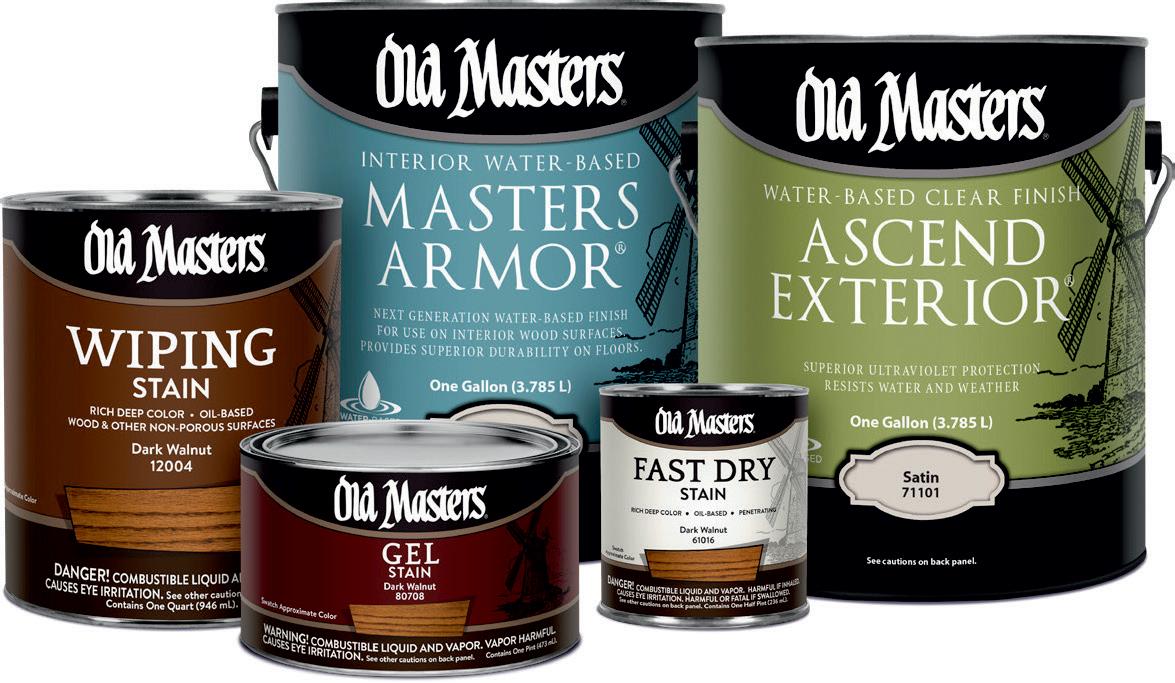


1025 E. 54th St. Indianapolis, Indiana 317-275-9400 NHPA@YourNHPA.org YourNHPA.org
COMMUNICATIONS
Lindsey Thompson Senior Content Manager lthompson@YourNHPA.org
Melanie Moul Research & Enterprise Content Manager mmoul@YourNHPA.org
Jacob Musselman Content Coordinator jmusselman@YourNHPA.org
Autumn Ricketts Graphic Designer
Olivia Shroyer Graphic Designer
Austin Vance Production Manager
Samantha Mitchell Production & Design Assistant
Freda Creech Sales & Production Assistant
Nathan Piper Marketing Coordinator
ASSOCIATION PROGRAMS
800-772-4424 | NHPA@YourNHPA.org
Katie McHone-Jones kmchone-jones@YourNHPA.org Director of Member Outreach & Events
Kim Peffley kpeffley@YourNHPA.org Director of Organizational Development & Consulting
Jesse Carleton jcarleton@YourNHPA.org Training Manager & Editor
Renee Changnon rchangnon@YourNHPA.org Retail Engagement Specialist
Jordan Rice 217-808-1641 | jrice@YourNHPA.org Regional Sales Director
CIRCULATION, SUBSCRIPTION & LIST RENTAL INQUIRIES
CIRCULATION DIRECTOR
Richard Jarrett, 314-432-7511, Fax: 314-432-7665
OUR MISSION
The North American Hardware and Paint Association (NHPA) helps independent home improvement and paint and decorating retailers, regardless of affiliations, become better and more profitable retailers.
NHPA EXECUTIVE STAFF
Bob Cutter President & CEO
Dan Tratensek
Chief Operating Officer & Publisher
David Gowan
No longer just a sci-fi pipe dream, artificial intelligence (AI) is being used in a myriad of ways to improve efficiencies and overall operations in industries across the board. In the August issue of Paint & Decorating Retailer, we’ll explore how AI has the potential to positively impact the independent channel and save operations time, money and energy.
PAINT & DECORATING RETAILER
(ISSN 1096-6927): Published monthly except December by the North American Hardware and Paint Association, 1025 E. 54th St., Indianapolis, IN 46220. Phone: 800-737-0107. Subscription rates: January through November issues, $50 in U.S., payable in advance. Canada $75 per year. All other countries $100 per year. Single copy $7, except July issue, $25. Periodicals postage paid at Indianapolis, Indiana, and additional mailing offices. Postmaster: Send address changes to Paint & Decorating Retailer, P.O. Box 16709, St. Louis, MO 63105-1209. Returns (Canada): Return undeliverable magazines to P.O. Box 2600, Mississauga, Ontario L4T 0A8. PM# 41450540. Copyright © North American Hardware and Paint Association, 2024.
Chief Financial Officer & Executive Vice President, Business Services
Scott Wright Executive Editor
Whitney Mancuso Executive Director, Marketing, Sales & Partnerships
NHPA BOARD OF DIRECTORS
CHAIRMAN OF THE BOARD
Ned Green, Weider’s Paint & Hardware, Rochester, New York
EXECUTIVE VICE CHAIRMAN
Joanne Lawrie, Annapolis Home Hardware Building Centre, Annapolis Royal, Nova Scotia
DIRECTORS
Alesia Anderson, Handy Ace Hardware, Tucker, Georgia
Jay Donnelly, Flanagan Paint & Supply, Ellisville, Missouri
Ash Ebbo, Clement’s Paint, Austin, Texas
Scott Jerousek, Farm and Home Hardware, Wellington, Ohio
Michelle Meny, Meny’s True Value, Jasper, Indiana
Michael Sacks, FLC Holdings, LaGrange, Texas
SECRETARY-TREASURER
Bob Cutter, NHPA President & CEO
NHPA CANADA
NHPA CANADA
Michael McLarney, +1 416-489-3396, mike@hardlines.ca
330 Bay Street, Suite 1400 Toronto, ON, Canada M5H 2S8

Over the last few years, retailers have been prioritizing creating in-store and online experiences for their customers. Featuring exclusive data from the North American Hardware and Paint Association, meet three retailers with distinct approaches to their online presence.

See You in Sunny Florida In just a few short weeks, the Independent Home Improvement Conference will kick off in beautiful Marco Island, Florida. Here are 10 reasons why you should get your ticket booked today to attend.
Under the Surface Painting is still the leading project homeowners undertake to enhance any room or space, according to data from the Home Improvement Research Institute. Gain insights behind the most popular spaces people are painting and how you can guide them.
CATEGORY FOCUS
The Pulse An Indiana paint retailer shares three best practices for merchandising and carefully selecting impulse products that will help bolster ticket sizes and give your impulse category variety that sells.







ON A RECENT TRIP to the West Coast for our HR Training Roundtable group’s annual meeting, my trusty iPhone decided to die the day before the meeting started. It was a complete black screen event, and despite a few flickers of the Apple logo gasping for air, there was no bringing it back. As the moderator of the roundtable, I had no way to communicate with the dozen retailers arriving within 24 hours who would be texting and calling for guidance and directions. It couldn’t have been worse timing to lose my communication lifeline.
It’s times like these I realize how much we take for granted our reliance on personal technology (e.g. our smartphones) and how unconnected and lost we feel without it. After the panic subsided, I remembered that it wasn’t my only means of communicating. It was just the easiest way.
“It is my honor to serve this association and industry by returning full circle to help run our media properties.”
Back when I last held an editorial title with this magazine 20 years ago, we operated pretty efficiently in an analog world. The Blackberry ruled supreme, and the first gen iPhone wouldn’t be released for a few more years in 2007. Back then we weren’t writing about autonomous robots that shoot “outs,” we were writing about inventory management best practices. We weren’t writing about electronic shelf labels (ESLs), but we were writing about pricing strategies to stay competitive with the big boxes. Like my phone, the robots and digital bin tags are just tools used to perform functions retailers have been doing quite successfully for years.
I have been fortunate to have worked in each of the various divisions here at NHPA in my 30-year career. The first decade was in our publication department, visiting stores and writing articles for the magazines we produced. This is when I fell in love with this industry. The next 10 years, I headed up our member services department, serving our group membership accounts and helping develop programs that are still widely used today, such as our Basic Training product knowledge series that remains the industry’s gold standard. During the past 10 years, I’ve helped launch our advanced training curriculum, including our previously mentioned retailer roundtable series, as well as our Retail Management Certification Program and Foundations of Retail series.
All of this has provided perspective on the multiple paths to success that exist in this business, both analog and digital. I’ve come to find that independent retailers are unique, entrepreneurial beings who find ways around life’s obstacles in order to be successful and serve customers. The common denominator to success is the relationships they forge with their staff members and their customers by putting people first.
It is my honor to serve this association and industry by returning full circle to help run our media properties so we can continue NHPA’s 124-year legacy of developing and disseminating meaningful content that helps retailers become better and more profitable. This has always been the association’s mission, and my mission will be to see that Paint & Decorating Retailer continues to lead the industry forward, providing the quality content, actionable ideas and compelling research our members have come to rely upon to be able compete both online and in the aisles of your stores.

Scott Wright Executive Editor
How to Reach Dan Dan Tratensek dant@YourNHPA.org

Irecently had the opportunity to speak to a group of the top manufacturers in the home improvement industry. During my presentation, it struck me how much the climate in the industry has changed over the last couple decades and especially the last few years.
It wasn’t that long ago that the entire channel was focused on the rise of the big boxes and at NHPA, we felt like we were constantly having to make a case for why independents still mattered.
Yet, here I was, invited to speak to this group of industry leaders about the state of the independent channel and what its future might look like. All of these companies were interested in how they could support and partner more effectively with independents.
But why? And why now?
Why are independent retailers top of mind while the big boxes are out there capturing about half the sales in the channel? Why, when Amazon continues to roll over the retailing landscape like a tsunami?
To me, there are a couple of reasons.
First, as it relates to the big boxes, independent retailers have survived this market push. You stepped up to the big bullies on the block and punched them in their noses and have created a “quiet peace” where big boxes and independents coexist.
“The support of key channel partners hinges on you keeping up your end of the bargain.”
You did this by being agile, responding to market opportunities and offering customers an alternative experience to the low-service, cavernous home improvement warehouses.
As far as Amazon, you are also finding ways to pivot. You are adding e-commerce features to your operations, engaging in local advertising and showing your customers you can still be convenient in the era of next-day delivery.
For all these reasons, the other members within the home improvement channel still look at independent retailers as a pathway to growth. Although the general sentiment has changed from 20 years ago when channel partners’ growth strategy was transfixed on the boxes, it can just as easily change today.
The support of key channel partners and these partners’ belief in the future of independent retailers and the growth they offer hinges on all of you keeping up your end of the bargain. This includes continuing to invest in your operations, continuing to be open to adding new products, continuing to focus on the needs of your specific market and continuing to stay ahead of consumer trends.
Without this kind of vision and willingness to invest in your own futures, channel partners’ prospects for growth with independent retailers will once again dim and there will no doubt be another competitor out there eager to step in to replace you.

Dan M. Tratensek Chief Operating Officer & Publisher
Teaching your team about best practices for controlling cash flow is essential for growth. Learn more about the new Navigating Cash Flow course at YourNHPA.org/cash-flow
Gary Pittsford has helped hundreds of family business owners with valuations, exit planning, estate documents, retirement income security and net worth protection. Gary served as president and CEO of Castle Wealth Advisors, which was acquired in 2021 by Creative Planning to form a new division providing services for corporations, LLCs, family limited partnerships and others across a range of industries. Creative Planning Business Services offers expanded services for business owners. Gary retired from Creative Planning in December 2023 and now functions as a consultant, continuing to work with business owners nationwide.

About 40 years ago, most everyone in the retail home improvement industry had just one store. In the last 20 years, and especially in the last 10 years, it has become more common to see business owners acquire other stores or build brand new stores in order to grow their company. As most of you know, opening the second store is the hard one, but after that, the third and fourth store are a little easier.
Some of you may double the size of your retail square footage in one store and then some of you will acquire a second location in order to grow the business and create more stability and income for the family.
Growth in your company creates higher income, more financial security and better support if the next generation is going to take over the business.
Growth and profitability increase the value of your company and increase your personal net worth. The higher valuation and higher net worth for you makes it easier to think about retirement in a few years.
Some of you own several stores and no real estate, but probably at least half of you also own the real estate where the stores are located. By owning several stores and several buildings, it makes your retirement goals easier to reach.
If the next generation in your family is going to take over the business, most younger retail home improvement professionals like having a larger company with perhaps more than one location. It is easier for them to rapidly adopt new modern technology to run the company. This new technology in software and equipment will allow your company to grow faster, and hopefully more profitably.
Growth will give you the needed income to hire one or more of your children to take over the company and also hire more qualified store managers.
Growth for the future cannot happen without great employees who are well trained in all facets of running a retail home improvement business.
Many of you started your business 40 or 50 years ago with zero income, and now you have a substantial business with great employees and loyal customers. Doubling your business in the next 10 years will be much easier because of the technology systems and people that you have in place right now.
Growth is good for your net worth, good for your retirement, good for your family and good for your community. Don’t stop now.
Gary Pittsford Partner & Chief Valuation Officer (ret.) and Consultant Creative Planning Business Services
Communication Counts
The Everything DiSC® assessment measures your employees’ communication preferences so you can create a more cohesive work environment. Learn more at YourNHPA.org/disc






What do I do when my boss doesn’t want to hear my ideas?
—Assistant manager, multistore paint operation
It can be frustrating when your boss doesn’t seem receptive to your ideas. Here are a few strategies you can use to get your ideas heard.
• Create a plan: Planning ahead is crucial. It’s tempting to act on your ideas immediately, but taking a moment to think things through before discussing them with your boss can make your approach more effective.
• Pick the right moment: Timing is everything. Catch your boss when they’re not busy or stressed. Setting up a quick meeting can be better than dropping your idea out of the blue.
• Understand their perspective: Try to understand why your boss might not be open to your ideas. Maybe they are focused in different areas or they simply need more information.
• Align with the company goals: Present your ideas in a way that aligns with your company’s culture and goals. Demonstrate how your ideas can solve a problem or add value to the organization.
• Be prepared: Come prepared with data, examples and a clear plan. Get to the point quickly to maintain their attention and interest.
• Try a different delivery: We all have different communication styles, so consider what delivery type will work best for your boss. If you’re always presenting your ideas verbally, try writing out your plan.

Kim Peffley is the
• Be open to and seek feedback: If your idea isn’t approved, ask for feedback on how your idea can be improved to be considered in the future. Seeking feedback shows you are open to improvement and willing to understand their perspective.
• Share any successes: If your idea has been successful for you personally, and you believe it could benefit your team, explain how and why it will be helpful for others.
• Stay professional: Even if your ideas aren’t immediately accepted, remain professional and continue to contribute positively. When you focus on improving your overall communication, sharing new ideas becomes easier. Be cognizant of your communication style and others around you. The key is to adapt your message to ensure it is received. For me, utilizing my DiSC assessment really helped with this. Keep the good ideas coming. I can’t wait to see what you will do next.
Now, let’s go out and make a difference in someone’s day today!
Kim Peffley Director of Organizational Development & Consulting North American Hardware and Paint Association
The deadline to participate in the 2024 Cost of Doing Business Study has been extended to July 15. Participate in this industry benchmarking tool at YourNHPA.org/codb
of independent home improvement operations helps the entire channel understand how they compare to the industry at large. Since 2022, the North American Hardware and Paint Association (NHPA), in partnership with The Farnsworth Group, has fielded the Independent Retailer Index, which tracks key performance metrics on a quarterly basis. We recently surveyed retailers on their performance in the first quarter of Q1 compared to Q4 2023. See highlights of the data here and download the full report at YourNHPA.org/retailer-index.
Be sure you’re on the list to receive the newest data from the Independent Retailer Index every quarter. Head to YourNHPA.org/research to subscribe today.


Retailer Recommendations
Send an email to editorial@YourNHPA.org telling us about the products your customers love and why they are such a hit in your business.
COLOR SENSOR
NIX SENSOR
nixsensor.com
Instantly match over 200,000 brand name paints with the Nix Mini 3. The sensor can instantly provide RGB, HEX and CMYK codes of scanned colors, no calibration required. The sensor is splash-resistant, made in Canada and has a one-year warranty.
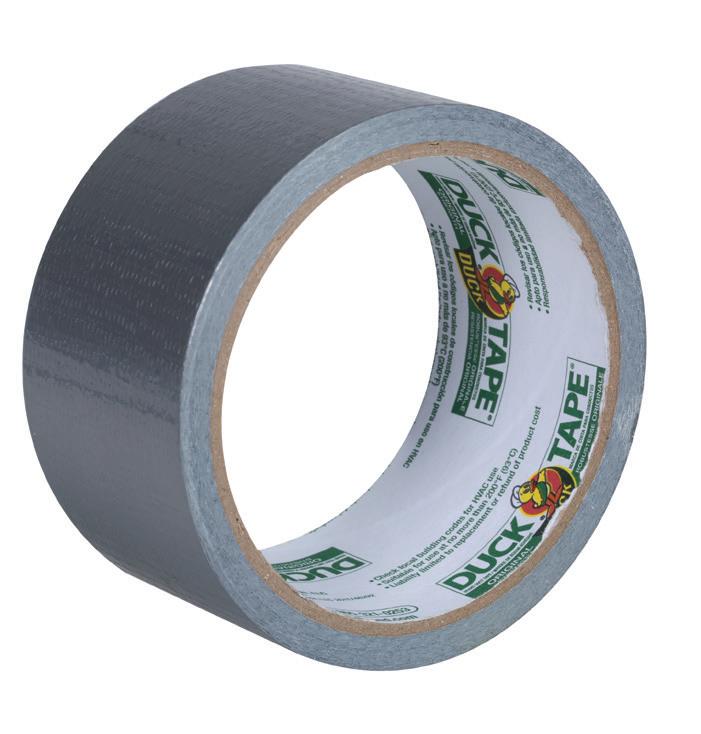

DUCT TAPE
DUCK BRAND duckbrand.com
Featuring waterproof backing and better adhesion, this easy-to-tear workbench favorite is great for holding, seaming, sealing and bundling. Its strength and conformability make this tape ideal for those difficult DIY projects that involve corners, bends and curves.
WOOD CHISEL SET
SPEC OPS TOOLS
specopstools.com
The Spec Ops Bevel-Edge Wood Chisel Set comes with ¼-inch, ½-inch, ¾-inch and 1-inch sizes. Spec Ops’ chisels are forged from high carbon steel for maximum edge retention and then precision honed to razor sharpness. The beveled sides help reduce friction when cutting mortises or deep pockets. The shock-absorbing grips feature a deep thumb pocket for slip-free control, while the hardened metal strike caps withstand a lifetime of mallet or hammer strikes.
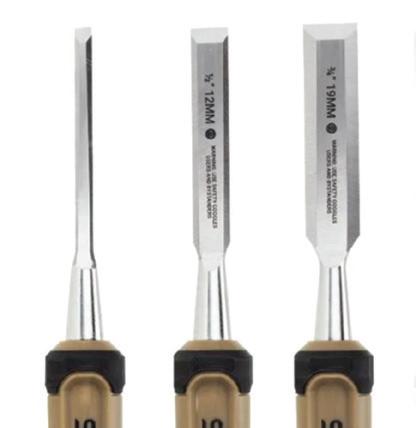


outdooredge.com or 888-249-6942
With a compact 2.5-inch blade option, the RazorWork is made from Japanese 420J2 stainless steel that has been heat-treated and hand-finished to achieve a long-lasting razor-sharp edge. The straight edge design of the utility blade transfers power directly to the cutting edge. When the blade dulls, it can be quickly and safely exchanged for a new blade thanks to the proprietary Outdoor Edge RazorSafe system. The handle is constructed from a lightweight, one-piece, nonslip glass/nylon polymer.


MOSAIC TILE MARBLE SYSTEMS marblesystems.com
The Skyline Leather Marble Collection from Marble Systems comes in a variety of tile and mosaic patterns. With multiple color and sizing options, these marble tiles are made for interior use including walls, floors and backsplashes.
DAP GLOBAL
dap.com
DAP HD Max Construction Adhesive is a high-performance, premium moisture-curing adhesive that bonds in extreme temperatures. This adhesive delivers a durable, waterproof bond, provides adhesion to nonporous building materials and is available in 9-ounce and 28-ounce tubes.
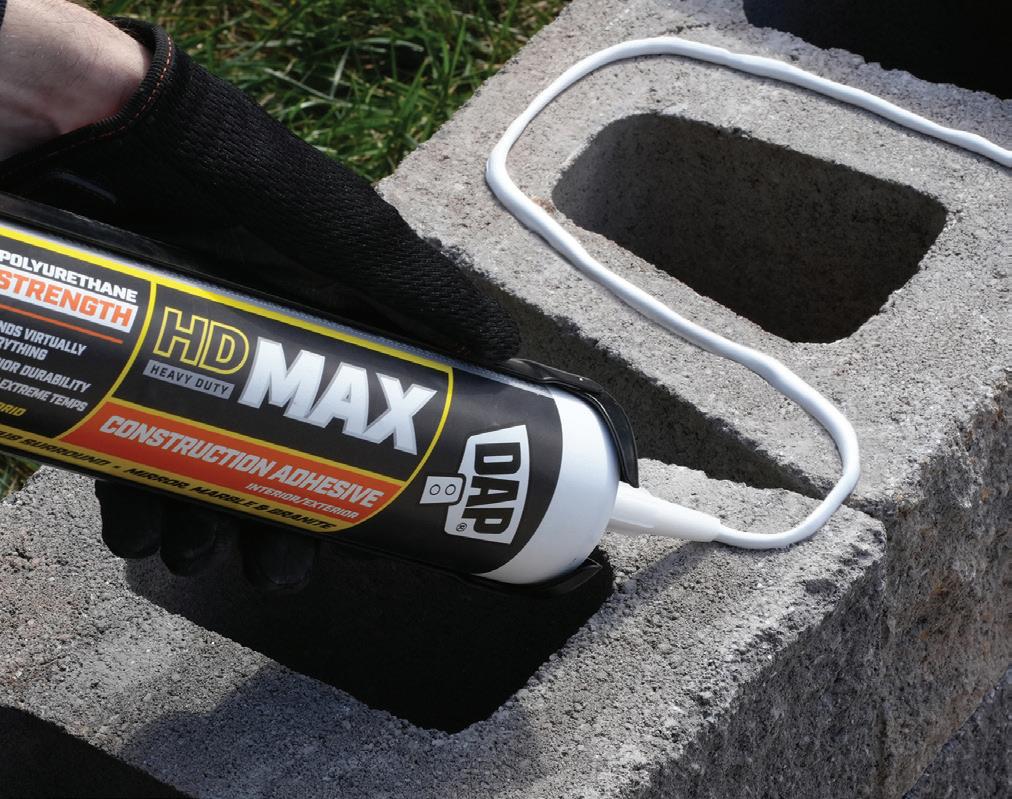
PAINTBRUSH SET
ALLWAY TOOLS
allwaytools.com
The ALLWAY® Ergo-Style Paintbrush Set features a unique ferrule construction using extruded aluminum, so there are no locking joints or nails to loosen over time and the aluminum does not rust. All three brushes have ergonomic grips with high-quality, tapered polyester bristles and tips. The set includes 1- and 1 ½-inch angled brushes and a 2-inch flat brush.







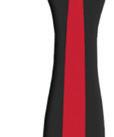




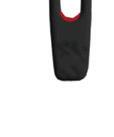
















TELESCOPING PAINT POLE
MONKEY RUNG PRODUCTS monkeyrung.com
The iSpray360® is a durable and lightweight telescoping paint pole featuring a control arm that allows for easy movement of the spray tip up and down. It rotates 360-degrees left and right, allowing painters to reach more spots in less time at every angle with less moving around, effort and fatigue.
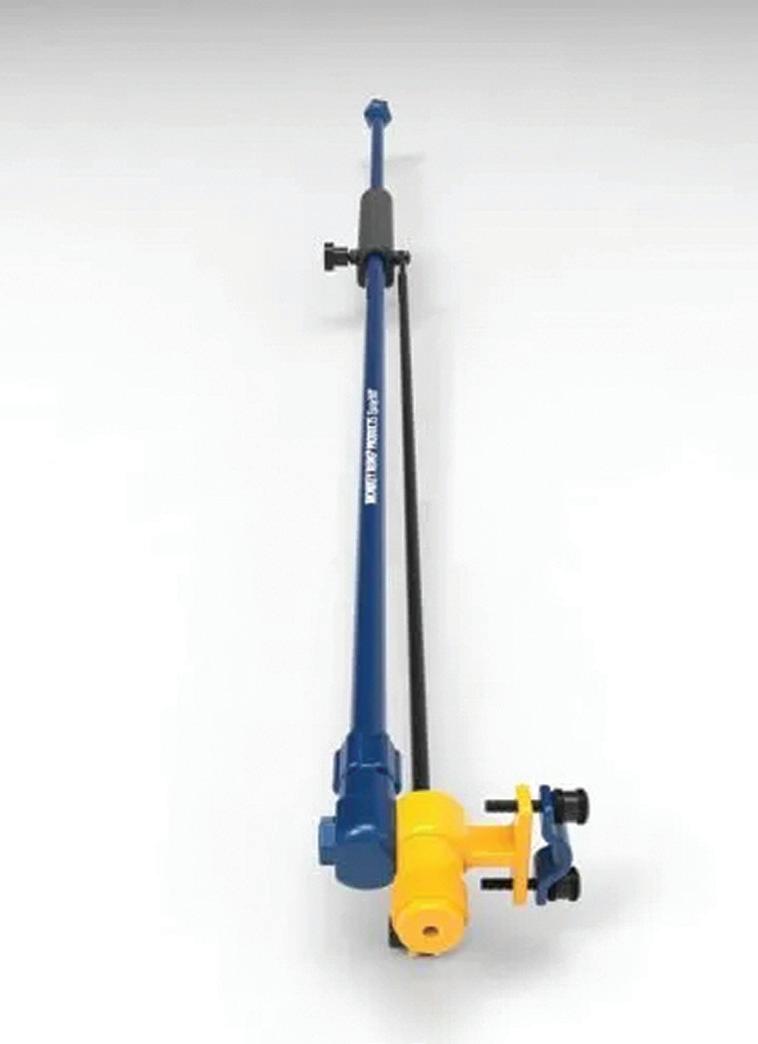


PROUDLY MADE IN USA Since 1953

























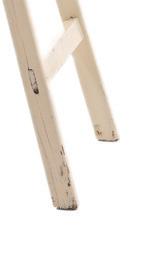






FAN MILWAUKEE TOOL milwaukeetool.com
The M18™ Brushless 18” Fan delivers corded performance anywhere on the job site, providing air circulation over 50 feet and up to 13.5 mph. The 18-inch blade and brushless motor quickly propel air, allowing for fast and efficient cooling, drying or ventilation. The reinforced metal base and shroud design withstands demanding job site environments and delivers impact, water and dust-resistance.
BATHROOM FAUCET HOUSE OF ROHL houseofrohl.com
The Modelle widespread bathroom faucet with a C-shaped spout comes in multiple finishes and is made to mount directly to a countertop. It produces 1.2 gallons per minute at 60 pounds per square inch.


TILE COUNTRY FLOORS countryfloors.com
With glazed terracotta tiles, mosaics and trims in five carefully crafted designs, the Traces Terracotta collection from Country Floors epitomizes organic modern interior design. Inspired by the tones of the Greek islands, the minimalist colors of white, beige, brown and blue with a glazed finish provide a handmade, artisanal look, creating welcoming spaces.

























AIR COMPRESSOR GRIP-RITE
grip-rite.com
The new Grip-Rite® RED System hand-carry compressor combines versatility, performance and quietness, making it the ultimate work companion for trade professionals. Operating at less than 60 decibels, it helps provide a quieter work environment without compromising performance.

LIGHTED COVER PLATE SNAPPOWER
snappower.com
The SnapPower SwitchLight is an innovative light switch cover plate with built-in LED lights that are activated by an automatic on/off sensor. The cover plate can be quickly installed without any wires, batteries or electrician required. The SwitchLight provides night accent lighting for your home and makes it easy to spot your light switches in the dark.

























T2024 Independent Home Improvement E-Commerce Study
is available to download now at YourNHPA.org/ecommerce


BY MELANIE MOUL

he question is not will e-commerce and web-based businesses supplant brick-and-mortar retailing… but will it simply leave you behind if you don’t adopt the technology and integrate e-commerce into the core of your business.




If you were to guess when that paragraph was written, you might say it was last week or maybe it was the height of 2020 when retailers were scrambling to put their inventory online and set up curbside pickup.
Would you believe it if you learned it was from a column by former Hardware Retailing magazine editor-in-chief Mark Parrott in December 1999?

Whether you can fathom it or not, retailers large and small have been trying to capture customers’ attention online for the better part of 30 years. Independent home improvement retail hasn’t been at the forefront of online strategy or e-commerce, likely because the channel hasn’t needed to compete against online giants in the same way as




say their independent bookseller counterparts. The industry has benefited from consumers’ desires to match paint to their curtains or consult the decades of knowledge that often resides inside the four walls of the local paint and decor store.
But the dynamic has changed.
Even in the last four years, and most definitely since 1999, customer expectations around a retail experience are significantly different. And the North American Hardware and Paint Association (NHPA) wanted to find out how retailers have been responding to those changes.








In a recent survey to about 200 retailers representing nearly 600 stores, NHPA asked respondents to share their approach to an online presence, including websites, e-commerce and digital marketing. Some respondents were gracious enough to offer additional insight into their strategies. On the following pages, learn from three of those retailers about their distinct approaches to being online.










E-commerce is 2% of overall sales
Exploring site to sell boutique brands
townlinepaint.com
Shifting focus to what will drive sales has been at the heart of Town Line Wallpaper & Paint since the business started in Malden, Massachusetts, in 1965. The company initially focused on wallpaper, with two-thirds of the store’s 5,000-square-foot salesfloor dedicated to imported paper and six full collections.
“My grandfather was a professional wallpaper hanger, and he decided he wanted to sell wallpaper instead,” says current owner Todd Zigelbaum, whose grandfather started the company. “Back then, wallpaper was king.”
Zigelbaum entered the business in the early 1980s, eventually buying the building and taking over operations with his brother. Since then, although wallpaper sales have become a smaller percentage of overall sales, the business was able to successfully pivot into also selling paint and offering design services.
Wallpaper led Town Line Wallpaper & Paint’s initial foray into e-commerce in the early 1990s, when the company started selling themed wallpaper online, including two unique sites focused on sports and kids patterns.
When several of their suppliers closed causing extreme supply chain issues, they chose to shut down those specialized sites. But then in 2020, Zigelbaum knew that being able to sell online would be critical for the survival of his business and another shift was warranted.
“When we first started to get a sense of what was happening, we connected with somebody who had helped create an e-commerce site for a large retail paint store out of New York City,” he says. “Paint stores were not initially deemed essential, and we didn’t know how long that was going to go on. For a long time, we had to service everybody from our parking lot. With a website, we thought we could at least ship products out of our store.”
The initial platform was functional for what it was, but Zigelbaum knew it wouldn’t work long term because
of the limitations of the e-commerce platform and the customization of the website. He wanted to maintain an online presence, so he worked with a vendor through the company’s partnership with Benjamin Moore to set up a new website that would be better suited to their needs. With this new website, Town Line has access to professionals they can rely on through the vendor. Internally, a long-time staff member is knowledgeable about the e-commerce platform they use, so he is able to help with quick fixes and updates.
“The vendor we work with, they’re great, especially if you’re just starting out,” Zigelbaum says.
Looking into the future, Zigelbaum says a top priority is establishing a system that allows him to link his POS information into his e-commerce site. Town Line Wallpaper & Paint is in a very saturated market, with 14 stores within a 5-mile radius. For Zigelbaum, that means he has to be very tuned into pricing, and that often means pricing is listed higher online than it is in the store. The current system doesn’t allow for multiple tiers of pricing and there isn’t a log in capability for customers with accounts to access contractor discounts.
There are also limits on how many products the platform can manage, so Zigelbaum is strategic about which products are listed online.
“We put the popular products that we sell every day into the site,” he says. “Our contractors



For Town Line Wallpaper & Paint, the website gives customers another layer of convenience to get supplies they need delivered.
Learn how Family Hardware owner Jeremy Peterson achieves 25% of overall sales from e-commerce with his custom-built POS, e-commerce and website platform at PDRmag.com/family-hardware
buy brushes and rollers online, and they’re able to have it delivered, so with that added convenience, the price difference doesn’t matter.”
Investing additional resources into the store’s online presence is a moderate priority for Zigelbaum over the next few years, but he says it’s important for retailers to make sure they understand what goes into maintaining an e-commerce site before they take the plunge. He recommends having the right team and systems in place from the start to be successful.
“You do need to have somebody there to guide you. You need to have the right POS people, the right e-commerce platform, and you need somebody on the programming side,” he says. “We have a marketing company that advises us on digital ads and content. We’ve used them to avoid disasters, which has been helpful.”
The next phase for how Town Line Wallpaper & Paint shows up online may not even have Town Line in the name. Zigelbaum says some of the boutique brands they carry are some of the best-sellers on the website, and they’ve explored ways to capitalize on that.
“We may be moving forward with another website that’s not branded to our store and will feature only the boutique brands that we carry,” he says. “We think there’s more opportunity in that segment from an e-commerce perspective.”

No website
Annual revenue: <$2 million
The legacy of True Value of Rock Hill goes back further than the store’s four-year history.
Co-owner Jay Simpson’s father owned and operated a hardware store in nearby Chester, South Carolina, and Alex Dorsey started working at that store as a teenager. The company and the ownership team, which included Simpson’s father and another business partner, had spent decades developing a reputation for service, knowledge and overall goodwill.
After 16 years in the business and earning an ownership stake in that business, Dorsey wanted to start his own store. At the time, Simpson had recently graduated from college and wasn’t sure what his next steps would be.
“Even though my dad had owned the store while I was growing up, I had no experience in the industry,” Simpson says. “But I thought I would give it a shot. It was certainly a big learning curve, but I learned that if you take care of your customers, they’ll keep coming back.”
Simpson and Dorsey worked with their wholesaler to open up the store in Rock Hill, which is about 20 miles from Chester and about the same distance from big-box competition. Dorsey and Simpson were confident that the reputation at the Chester store would carry over into the new location.
The two planned the store’s grand opening for April 2, 2020, the same day the state of South Carolina issued businesses to close due to the pandemic.
“We didn’t know what was happening,” Simpson says. “We probably stayed closed for about a month.”
Eventually, hardware stores were deemed essential and the store was able to reopen. In the meantime, Simpson had connected with a local veterinary lab that had started making hand sanitizer. True Value of Rock Hill became the only distributor of hand sanitizer in town, eventually selling over 15,000 bottles. They also started stocking face masks, including handmade ones from area residents. The store also donated PPE and sanitizer to local first responders.
“We kind of became a sanitary shop as well as selling hardware,” he says.
Since then, the business has continued to serve the community in unique ways. The 8,500-square-foot salesfloor is home to core hardlines products, and there is a power aisle for outdoor power equipment. But Simpson has also forged relationships with local farmers to serve as another place for shoppers to access fresh food. The store stocks frozen meat, raw milk, lettuce and eggs. They also sell canned goods and local grilling spices. Simpson says the raw milk draws people over 30 miles away from North Carolina, which has different regulations around raw milk sales.
The primary way the store communicates to customers about sales, new products and produce availability is through the True Value of Rock Hill Facebook page. The store doesn’t have a website, and Simpson says it’s not a priority for him right now because they have such a loyal following on social media.
Currently, the store has about 1,600 followers, and each post garners a handful of reactions, comments and shares. A post celebrating Dorsey’s birthday received 95 comments.
“We use Facebook as our primary source of advertising,” Simpson says. “We try to be very personable. It’s very relaxed. We’re not just the True Value store, we’re people of the community. We’re not just trying to make a profit, we have fun too.”
Simpson says the Facebook page is managed by a friend of his who stops by the store nearly every day to take photos and find out what promotions and sales are running. The majority of the posts are photos of staff, new displays or even just a simple photo of the store’s paint department. The process may be unconventional, but it’s working for them for the time being. Simpson also has access to the account and posts as needed.
The next phase of the operation’s online presence will be focused on digital marketing. They recently signed up for their wholesaler’s digital ad program that uses geotargeting to push ads out to people in the store’s service area. Simpson says the goal is that it will boost revenue by $30,000, and it’s managed by their wholesaler, so they don’t need to invest time in it on a day-to-day basis.
“We just started it, so we haven’t seen results yet, but we wanted to try it to see what it would bring in,” he says.
The majority of the True Value of Rock Hill customers are DIYers who are shopping for plumbing, electrical and lawn and garden supplies. Most homes in the area are at least 30 years old, so people are investing in upgrades or repairs.
Simpson says the time it takes to set up and manage a website is not something he can prioritize right now. Customers call and ask about a product, and he is happy to place the order for delivery on the next truck, which takes about three days. He says sometimes people call in thinking they are calling a different local store, but he’s happy to source an equivalent product and match the price.
To fill the e-commerce gap, Simpson says he considered selling on Amazon, but the fees they would take off the top of the sales made it cost prohibitive.
“I’m not against a website, I just don’t see a huge need for it at the moment,” he says. “We would probably have to hire someone full time to manage it, and that’s not in the cards right now.”
“We try to be very personable. It’s very relaxed. We’re not just the True Value store, we’re people of the community. We’re not just trying to make a profit, we have fun too.”
—Jay Simpson, True Value of Rock Hill
Been online since 1999
E-commerce is 2.5% of overall sales
coxhardware.com
For nearly 80 years, Cox Hardware & Lumber has been serving downtown Houston across three distinct segments. What started as a small business running out of a rented storefront behind Henry and Mary Cox’s family home is now a hub for commercial, industrial and residential business across southeastern Texas and beyond.
Taylor Cox is a purchaser and manager for the operation and is the fourth generation to be involved in the business. He joined in 2016 after serving in the U.S. Army.
The store carries about 31,000 SKUs, including traditional hardlines categories, with about 8,000 SKUs in fasteners alone, in addition to a large selection of abrasives, cleaning supplies and paint and industrial coatings. The lumber department is housed in a 7,000-square-foot pole barn, along with an acre of outdoor storage.
“We’re inside the loop here in Houston, which is the industrial belt,” Taylor says. “We kind of act like an industrial distributor.”
Virgil Cox has been involved in the business since he was in junior high in the early 1970s, and he started the company’s initial foray into a web presence. In the 1980s, Virgil compiled product information, including images, SKUs and manufacturer details, into comprehensive catalogs spanning nearly the store’s entire inventory, printing and mailing 5,000 copies. In 1999, he led the process of converting the catalogs into the company’s first website in order to drive online traffic into the store.
Taylor says driving in-store traffic is still the basis of their online strategy today, although the website has undergone numerous updates since that first iteration, including several major e-commerce enhancements.
About 2.5% of the company’s overall sales are online transactions, but Taylor estimates that percentage would be higher if it incorporated implicit sales.
“Someone will walk in with our website pulled up on their phone and buy a product they found online in store,” he says. “And a lot of customer phone calls are about something they see on the website.”
The current version of the website was initially developed about 10 years ago, and Taylor says it was built
The 2024 Independent Home Improvement E-Commerce Study gives insights into the spectrum of the independent channel’s approach to being online. You’ll find data around the platforms your peers are using, where they’re getting their product information, how they manage orders from in-store pickup to delivery and the tools they find most successful for digital marketing. To see the complete report, go to YourNHPA.org/ecommerce.
of overall sales on average 3.4% E-commerce represents about of total e-commerce sales are buy online, ship to home 33% of respondents have e-commerce 49%
Source: Independent Home Improvement E-Commerce Study, NHPA, 2024





















































































































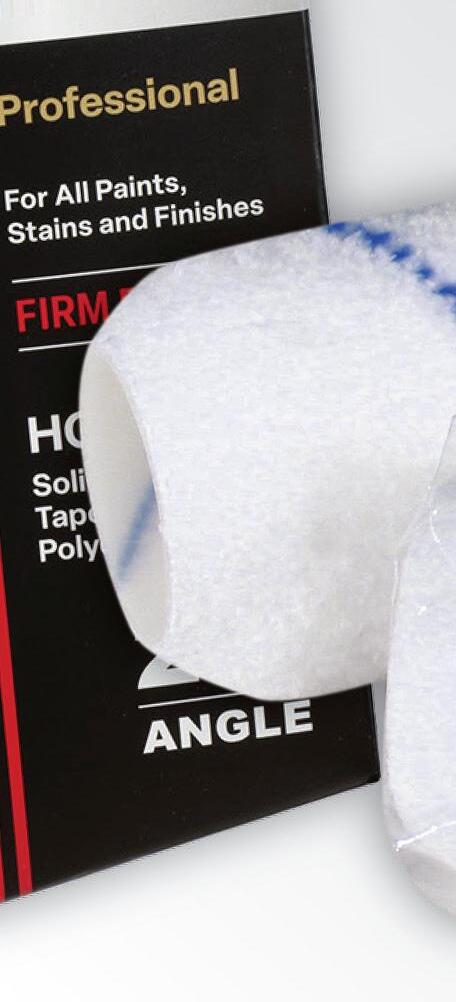





















to extend the store to their customers’ desktops. The landing page allows shoppers to choose items from a list of departments, brand names or search for a specific item or part number. It also shows the featured items, including sale items and new products. Each individual item listing includes the SKU, brand name, item weight and quantity available. At the bottom of the page, there are recommended items that are related to the product, whether they are frequently purchased together or are items that are needed to use the selected product.
Taylor says about 60% of the product information comes from their wholesalers, but the remaining information they source from the vendors they buy from directly. Taylor says about 60% of orders are buy online, pickup in store and the remainder are shipped from the store’s inventory throughout the contiguous U.S.
Website manager Joann Rodriguez has been with the company for 28 years and was present for the website’s inception. Today, she oversees the website’s operation and day-to-day tasks such as SKU deletions, product data enrichment. For other more complex maintenance and issue resolution, they rely on their developer who is based in Boston. Shipped orders are managed by another team member.
“The team we have managing website updates and orders is integral to the success of the site,” Taylor says.
The store primarily uses UPS for shipping and customers pay for shipping. Taylor says they don’t offer free shipping, but some items are eligible for a quantity discount, which they also offer to in-store customers. For some people, the shipping is worth it if it means they can access hard-to-find items. They recently had a customer order one sheet of crocus cloth for $1.20 and pay full price for shipping because he wasn’t able to locate the product anywhere else.
About two-thirds of the orders placed online come from commercial/industrial customers. Customers with
store accounts are able to pay with a purchase order online and have the option to log into the website and see their order history, which is a big draw for Cox’s large professional customer base.
A major challenge for online retail is to maintain repeat business, Virgil says.
“It’s easy to get someone to visit once, but in order to get them to return again and again, you have to offer something that the customer wants, or even needs, that is unavailable elsewhere,” he says.
For every product on the Cox Hardware website, inventory detail like quantity on hand, quantity on order, price and available discounts are served to the website every few minutes all day long from the in-store server. The information is date and time-stamped, which Virgil says is to communicate relevance to potential customers. The goal is for that dynamic product data, combined with relevant product descriptions and images, to give enough information for customers to be able to make a purchase decision.
A critical piece of a successful e-commerce strategy is accurate inventory, and the Cox Hardware & Lumber team takes that seriously. Each department head counts a certain amount of their department every day using an RF gun. Progress is tracked in the office and updated on a fixture map of the salesfloor, showing the store manager the count status of the whole store. Additionally, management staff check the previous day’s counts and double-check variances for accuracy. Those variances are communicated back to staff and are a key performance indicator of reviews.
That data is what sets Cox Hardware & Lumber apart from other operations, either in-store or online, Virgil says.
“People go to the web for information,” he says. “Our commitment, dating back to our catalog days, has always been to provide our customers with all the information they need to be sure they’re getting the right product. The website makes it easy for them to find that information quickly. Our process ensures that the data we present is accurate and trustworthy. This lets us extend our store to our customers’ computers or phones.”
While Taylor and Virgil are happy with the system they have in place, at a decade old, they understand that this version of the website could use an update. The next phase is modernization, mobile optimization and assessing the content.
“We have parts of an update prepared, but we’re still testing it out,” Taylor says. “We have a lot of data now, and we’re looking at ways to integrate that with vendor and manufacturer data.”
Taylor says retailers who haven’t gotten online should consider what it can do for their business, even without e-commerce, from a visibility perspective.
“Our website is integral to our business. We’re getting really good with lead generation. If people search for something like ‘hardware store in Houston,’ we’re near the top of the results,” he says. “If you’re not online, you need to look in the mirror.”

























































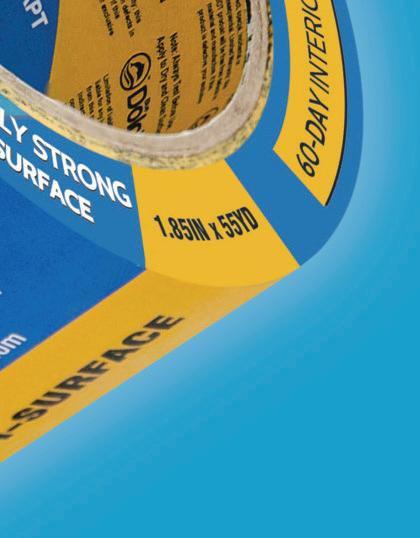





















































The IHI Conference keynotes, panels and breakout sessions will refresh, redesign and recharge how you think about retail operations and innovation (ROI)—learn more and register at ihiconference.org
Not often does a person’s determination and grit lead to a movie made about their life.

Daniel “Rudy” Ruettiger is one of those rare cases, with his life portrayed in the popular movie “Rudy.” As the son of an oil refinery worker and the third of 14 children, Rudy rose from valleys of discouragement and despair to the pinnacles of success. It took years of fierce determination to overcome obstacles and criticisms, yet Rudy achieved his first dream—to attend the University of Notre Dame and play football for the Fighting Irish. Before he shares invaluable insights into his mindset and approach to overcoming adversity as a conference keynote, Rudy shared details of his journey to realize his dreams.
Paint & Decorating Retailer (PDR): What was it like growing up in a large family? How did those experiences shape you?
Daniel “Rudy” Ruettiger (DR): It’s like being in the military. When I was in the Navy, we were very organized and everybody had a job, and growing up in a large family was similar to that. My mother had to be that way because my father worked three jobs; he was very disciplined too. Everybody was synchronized and organized, we ate at the same time and did our chores at the same time.
When you’re from a large family, you’re in survival mode getting through day-to-day life so there’s not a lot of time for dreaming. It’s not that my family didn’t want to help me achieve my dreams, they just didn’t know how because we were so busy and really had no time to think about it. But we did have fun together, playing sports and talking.






PDR: During your time at Notre Dame, did you ever think your story would be widely told and positively impact so many people?
DR: Definitely not. Everything I did, I did one step at a time. My first step was to get to junior college and do well there. So I never thought of it as a story or as a movie; that all came later after I looked back and reflected on how I got through it all by achieving the small goals in order to get the big goals.
PDR: Why is it important to stay focused when pursuing your dreams?
DR: You stay focused when you’re passionate. We dream a lot of dreams, but not all are real dreams, some are just fantasies. When it’s a real dream, that’s when you become focused and determined because you see what it takes to make it happen. You don’t worry about obstacles or challenges, you just move forward, and when they come, you handle them. Some people don't think the dream is worth it or it’s not for them, but if it’s embedded in your brain and your heart and your soul, it is for you, and you need to stay focused to achieve it.
PDR: What does it mean to you to live with purpose?
DR: Purpose is so important. If you don’t have a purpose, you have nothing. The only reason I went to Notre Dame was for my family, my father and mother. They could not dream that type of dream because they were so caught up just getting through life, jobs and the kids. I guess I wanted to show them the freedom of a dream. I was doing it for them, and every time I wanted to quit, I thought about them and it made me work even harder.
Visit PDRmag.com/2024-keynotes to read the Q&As with the IHI Conference’s other keynote speakers, Arthur and Al.




Register Now + Save
Time is running out to get your tickets and hotel rooms. Visit ihiconference.org today!
6
FROM EXPERTS
The main stage will also host three panel sessions led by industry experts and fellow retailers sharing insights on employee hiring and retention, reaching growth goals and innovating in your operation.
7
DIVE INTO SPECIFIC TOPICS
The IHI Conference morning breakout sessions will deliver curated insights with specialized breakout sessions delving into technology, operations, employee engagement and marketing, merchandising and advertising.
8
CELEBRATE THE INDUSTRY’S BEST
During the IHI Conference, three prestigious industry awards—the Beacon Awards, the Top Guns Awards and the Young Retailer of the Year Awards—will honor retailers making positive impacts in their operations, their communities and the industry as a whole.

9
AUGUST 28 | 1:30 P.M.
Beyond Survival: Creating Growth in a Flat Economy
Hear from a dynamic group of retailers who make strategic choices to drive growth in their operations, regardless of what the economy has in store.
Panelists: Dave Ables, Three Sons Hardware; Jeff Grasty, Florida Paints; Josiah Gates, The Aubuchon Co.
AUGUST 29 | 1:15 P.M.
Why Is This so Hard? Navigating the Labor Dilemma
This panel offers a platform for attendees to glean insights from industry leaders who are pioneering unconventional methods for sourcing, retaining, motivating and compensating their teams.
Panelists: Gina Schaefer, A Few Cool Hardware Stores; Yilda Marte, Sunshine Ace; Leonardo Osorio, Sunpro
AUGUST 29 | 2:15 P.M.
Innovation Unleashed: Inspiring Stories From NHPA Top Guns Honorees
These industry luminaries share their remarkable stories of innovation, community stewardship and strategic vision that have shaped the landscape of independent home improvement retail.
Honorees: Glen Morosohk, Ricciardi Bros.; Wendy Stine, Stine Home + Yard; Darren Tomasini, Dazey's Supply
IHI Conference attendees will have the chance to win two big giveaways. The winner of the Lead to Succeed Giveaway will receive an NHPA In-Store Leadership Training and the winner of the Race Day Giveaway goes home with tickets to the 2025 Indianapolis 500.

10
ENJOY FUN AND SUN
The IHI Conference will take place at the stunning JW Marriott Marco Island Beach Resort. Before and after conference events, you’ll have plenty of time to take in beautiful beachfront views and enjoy the resort’s three pools, golf, excursions and more.

Exclusive to Premier Members, NHPA Licensing is a comprehensive industry-specific training solution for independent retailers.

43+ COURSES, 273+ MODULES
Incorporate NHPA’s library of industry-specific courses on your own learning management system (LMS). Gain full access or select courses à la carte.
EXPERTLY CREATED
Courses developed by industry leaders with decades of retail experience and success.
COST-EFFECTIVE
Easily add courses to your LMS, saving time and money.
PROVEN RESULTS
Enhance employee skills, boost productivity and drive growth.

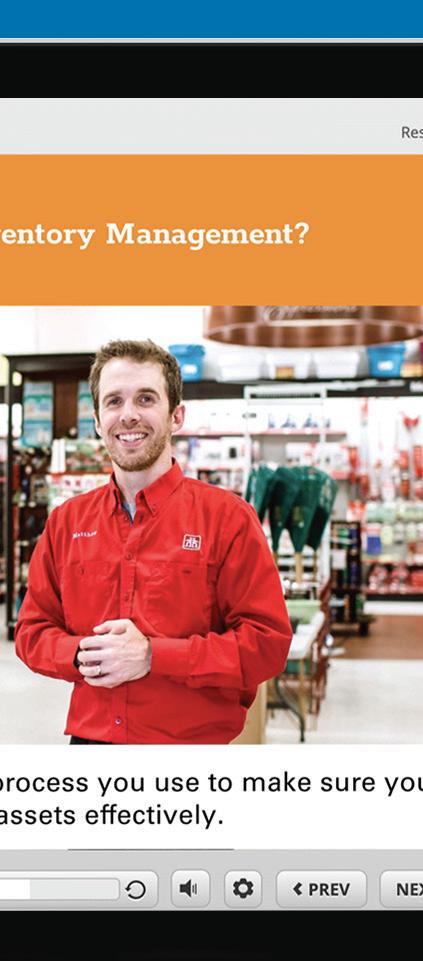
“NHPA
—Rodney Bullion, TAL Holdings LLC.


See You in Chicago
Don’t miss the HIRI Summit, September 18-19 in Chicago, to connect with the industry’s leaders in data and learn firsthand about the top issues shaping home improvement. Register today at hirisummit.com
Provided by the Home Improvement Research Institute
As home improvement trends come and go, one project consistently leads in popularity for homeowners: painting. According to findings from the Home Improvement Research Institute (HIRI), painting continues to be the most common activity undertaken to enhance any space, with a significant surge noted in the consumer market compared to the professional sector. Review the data here to uncover homeowners’ motivations behind the top rooms they are repainting.
HIRI’s Project Decision Study on Interior Painting reveals a distinct hierarchy in the popularity of rooms painted in 2023. This list showcases a preference for refreshing spaces associated with relaxation and socialization, aligning with the desire to create inviting and aesthetically pleasing environments.
KITCHENS AND LAUNDRY ROOMS
OFFICES, WORKSHOPS AND GARAGES
BATHROOMS
HALLS OR FOYERS
LIVING ROOMS OR DENS
DINING ROOMS
Of respondents in HIRI’s Project Decision Study, 47% cite the desire to update their house’s look as their primary driver for taking on a painting project. Additionally, 36% are motivated by the satisfaction of a job well done, highlighting the emotional fulfillment derived from transforming living spaces.
When it comes to initiating and executing painting projects, HIRI data reveals key insights.
• The decision-making process typically begins with the female head of household, indicating their influence in painting related home improvement endeavors.
• The need for updating or repair serves is the tipping point for 47% of interior painting projects, emphasizing the practical aspect of enhancing the home’s condition.
• DIY is most common, with 79% of projects completed without hiring a professional. This approach not only allows homeowners to exercise creativity but also fosters the aforementioned sense of satisfaction.
Timing plays a crucial role in interior painting projects, with January being the peak period for ideation. Spring serves as the top season for making the go-ahead decision, with March through June witnessing a flurry of project commencements. While demand may be subsiding around July, retailers can use this information to plan ahead for effective inventory management, marketing strategies and customer engagement.
Material selection predominantly falls under the domain of the female household head, who accounts for 70% of decisions regarding design and functional materials. Buyers prioritize factors such as attractiveness, price, durability and brand reputation when making purchasing decisions.
Brick-and-mortar retailers remain the preferred destination for acquiring painting materials, with 85% shopping at home improvement centers.
As trends evolve and preferences shift, understanding the underlying motivations driving these projects is crucial for home improvement retailers. Armed with data from the Home Improvement Research Institute, you can better tailor marketing and customer engagement strategies for specific products throughout the year.

The Home Improvement Research Institute (HIRI) is the only nonprofit organization dedicated to home improvement research. The organization empowers its members with exclusive, ongoing home improvement data and information for making better business decisions. Members are the home improvement industry’s leading manufacturers, retailers and allied organizations. Learn more at hiri.org

When Olson introduces a new impulse item, he moves it around the store for the first few months to see where it generates the most sales. Since Olson’s store is roughly only 4,500 square feet, he is strategic about the inventory he brings into the store.
During certain times of the year, he places seasonal items on endcaps instead of traditional impulse items.
“In the months leading up to summer, a lot of our endcaps are stocked with swimming pool paint,” Olson says. “It may not be considered a typical impulse item, but pool paint is something we push a lot in the summer and by having it on an endcap, it gains the attention of customers who need this product.”
Olson says when a product on an endcap is in the customers’ line of sight, people will react quicker if it’s one of the first products they see when they walk into the store.
Another way Olson merchandises his impulse products is by stocking them near similar items.
Near his lighting fixtures, Olson stocks handheld flashlights, a small accessory that is similar to the surrounding products.
80%
of consumers shop impulsively at brick-and-mortar stores.
73%
of Americans say the majority of their purchases are unplanned.
67%
of all consumers have impulsively bought an item because it was on sale.
The average consumer makes almost 10
impulse purchases per month.
Source: Capital One Shopping Research
Brick-and-mortar stores have to do all they can to maximize their sales potential when a customer enters their store. Endcaps are one of the most valuable pieces of real estate in your store. A well-stocked, well-designed endcap can set the tone for the rest of the store.
It may seem natural to put featured or sale items on an endcap. Remember that customers will come into the store seeking out those advertised items. While you can put some advertised items on endcaps to help promote your price image, put some of them in the regular run of merchandising. Use the endcap locations to show shoppers additional items you want to promote but aren’t currently advertising.
Always keep endcaps fully stocked. Not only does it make for a more attractive display, but it also reminds customers you have everything they need. An emptier endcap might lead them to think you are running out of product. As you sell through items on the endcap, restock. If you start to run low on inventory, change out the product for something else.
There’s an ongoing debate as to how many items you should include on any particular endcap. Studies suggest that single-item endcaps make the most powerful impact while driving large sales increases. But there is also value in creating endcaps with multiple items, such as those with project-based items. The best approach may be a balanced one—have some endcaps with single items and others with multiple items.
ROTATE OFTEN
Stores with the most productive endcaps change the products every month, and some will change them every two weeks. It’s important that this piece of the merchandising strategy continually presents different items to customers so it appears something is always happening in the store.
In his spray equipment section and up at the checkout counter, Olson stocks various spray tips, partnered with bold signage with the price taking precedence. When he prices his spray tips, he isn’t trying to make as much of a profit as he does with other products.
“I’m very aware of our competition’s price on spray tips and purposely have our price stand out,” Olson says. “I purposely sell them cheaper to make them an impulse item.”
When considering what should be in your impulse category, think about small, fun and low-cost items. Customers are more likely to make an impulse purchase if the item is well-priced, easy to find or something that is unique.
One item that performs well for Olson is custom paintbrushes with his store’s name printed on the handle.
“We have this 1-inch brush at our checkout counter with our name and phone number on it, and we’ve sold countless number of them since I bought the store,” Olson says. “I set them right by our credit card processor so people see them as they are checking out.”
By placing his custom brushes where customers wait as they check out, it’s one of the many items they see and have a small amount of time to decide on the purchase.
“A lot of customers don’t make eye contact with our sales associates,” he says. “Hopefully, we can catch their eye with products instead as they are checking out.”
Being a store owner and traveling to markets throughout the year, Olson says he’s constantly approached by companies and sales reps looking to get their impulse products into his store. One of his biggest tips he’s learned in his few years of owning his store is to not jump at every opportunity presented. Rather, Olson takes a calculated approach to bringing in an impulse item.
“I have all sorts of companies reach out to see if their products will fit into my store,” Olson says. “I’ve had knife companies say their knives are used by contractors, and that every painter needs a knife, but we’re not a knife store. We’re a paint store. I do my homework on every product I’m presented with, and I don’t say yes all the time.”

“Companies reach out to see if their products will fit into my store. I do my homework on every product I’m presented with, and I don’t say yes all the time.”
—Patrick Olson, Maumee Paint & Supply
INDUSTRY EVENTS
Lancaster’s National Road Show
August 12-September 14 | lancasterco.com/events

BY MIKE DUBE Director of Marketing, Lancaster
WHO HERE IS OLD ENOUGH to remember the Yellow Pages?
Back in the day, if you were looking for products to stain your deck for a weekend project, you would pick up the Yellow Pages, flip to the “P” section for paint and choose the paint store with the biggest ad. You then probably scribbled the address on some scratch paper, returned the Yellow Pages to its home next to the rotary phone and made your way to the store, following your trusty paper map. The scary thing was, you had no idea what products that store stocked, if the store was open, if their reviews were good or how much it would cost.
Fast forward to today—all you need to do to find the right retailer for this weekend’s project is reach for your cell phone. With the right search words, you can find the store, see the available products, read other shoppers’ opinions, make sure the store is open and even click on the address to get turn-by-turn directions. However, all that information doesn’t just magically appear. It takes effort and sometimes a small expense to build a positive online presence. Remember, that full-page Yellow Pages ad didn’t just show up either. It came with a price. At the time, it was a necessity, just like having an online presence is today.
Here are three recommendations to be sure your operation turns up at the top of the list.
First, have an active social media presence. Whatever your platform of choice—Facebook, Instagram, TikTok, LinkedIn—the key word to attract potential customers is “active.” Posting new products, promotions and photos of your staff and customers’ finished projects is a good place to start. You can also reshare content from suppliers or social media influencers who are using products you sell. For additional exposure, you can buy ads on Facebook or Instagram to target viewers in your area.
Next, claim your online business pages. Setting up your store’s profile on Google Business or Yelp only requires a few key details, including your address, phone number, store hours and website. Claiming these pages allows you to monitor and respond to reviews, and if you spend a little money for a Google ad, you can appear near the top in a search. And don’t be shy to ask your satisfied customers to write a review. A positive review can make all the difference.

Finally, rely on your industry partners. If you’re struggling to know what kind of content to post, use your suppliers to help. Working in marketing at Lancaster, we regularly have customers request product images and information to support their online presence, and we are glad to help. If our customers are successful, then so are we.
Along with the “Yellow Pages”, I used a few terms that you may not be familiar with, like “paper map” and “rotary phone.”
If you’ve never used those tools, then you probably already understand how to improve your online presence. But if you have ever “let your fingers do the walking” through the Yellow Pages, you may need to consider changing the way you reach customers. Remember, half the battle is won once you get them through your doors.

Transform your approach to cash flow with hands-on sessions and real-world applications.
Are cash flow problems weighing down your business? It's time to turn the tide with NHPA’s latest course. You’ll gain the tools and insights to master both expense management and revenue enhancement.
Be part of this 2-day interactive course on Oct. 15-16, and then continue your journey with six weekly workshops designed to translate your learning into practical solutions for real-world business challenges.
Seats are filling up, claim yours at YourNHPA.org/cash-flow
Concrete methods to identify and reduce unnecessary expenses
Proven strategies to maximize revenue streams and capitalize on market opportunities
Tools for evaluating and strengthening weak points in your financial structure
Actionable insights to foster proactive thinking and long-term financial resilience
Free Webinar | July 26

Join course instructors for a sneak peek into expert strategies on managing cash flow. Discover quick steps you can take to identify symptoms of cash flow issues and what you can do to overcome them. Register at YourNHPA.org/cash-flow.



Kim Peffley NHPA Director of Organizational Development & Consulting and former retailer
Brian Young Retail consultant and former 3rd generation retailer with 25+ years of experience
Stay up to date on the latest industry news by subscribing to our newsletters at PDRmag.com/subscribe.

Households and businesses across Maryland will soon be able to recycle leftover paint after a new law was approved by the state legislature. Beginning in 2026, PaintCare, a nonprofit paint recycling program, will coordinate paint drop-off sites in Maryland, which joins 11 other states participating in this program.
The international ceramic tile and natural stone event held its annual meeting, hosting nearly 25,000 industry professionals from around the world. First-time attendees accounted for nearly 50% of total attendees. The event featured nearly 1,100 exhibitors from 40 countries and held breakout sessions and networking events.
Economic growth slowed during the first three months of the year, but consumers are spending more than last year. Gross domestic product grew 1.6% in the first quarter, less than half the 3.4% seen in the fourth quarter of 2023.
To read these news stories and other news, visit PDRmag.com/news
The paint manufacturer is constructing a new paint and coatings manufacturing facility in Tennessee, the first built in the U.S. in more than 15 years. PPG is also expanding its existing facilities in Ohio and Mexico. The expanded facilities will include new equipment and processes to increase manufacturing efficiencies.
Datacolor released software portfolio updates, including the integration of Colibri support and enhancements to its color-matching and quality control tools. The latest version includes new features like increased security and improved recipe correction.
Tap into NHPA’s educational programs to build the people side of your business and improve communication, reduce conflict and increase overall productivity. Learn more at YourNHPA.org/education/academy
NHPA’s Newest Educational Course Covers Cash Flow Conundrums
THIS FALL, the North American Hardware and Paint Association (NHPA) will launch a new educational course, which will guide retailers through managing cash flow to support growth and success. The session will be led by NHPA’s director of organizational development and consulting Kim Peffley and small business consultant Brian Young. Read their conversation here to learn what retailers will gain from the course.
Kim Peffley (KP): Tell us a little bit about your history in the home improvement industry. Brian Young (BY): My parents owned a small hardware and feed store in upstate New York. My grandpa bought the business in 1957, and my dad took it over in the 70s. When my family considered closing their business, I came back from college and took over.
In 2009, I won the NHPA Young Retailer of the Year award, which inspired me to open up more stores. In 2023, I sold my store to my family, retaining some stock in the company. I’m now consulting with small businesses, showing them how to Scale Up (their revenue) and Scale Out (cut their weekly hours) so they can reinvest their time into family, community and planning their operation’s future.
KP: Why is cash flow a big issue for retailers?
BY: We, as business owners, get all-consumed with the daily issues, problems, opportunities—the shiny things. Money doesn’t actually talk. It’s quiet. It’s not shouting at us and vying for our attention like our customers, employees, managers or others can be.
Cash flow will quietly shrink up on us and then when January, February or March rolls around, when our bank account is really bleeding, we notice. Here’s the problem—90% of small businesses that fail do so because of cash flow issues. When we have cash flow problems, not only can it be tough to pay bills, but we stop planning and expanding our businesses and go into survival mode.
We circle the wagons and focus on just the essentials, and this is never good. We then get stressed, pessimistic and can forget what we’re truly wanting to accomplish with our stores and our big goal of who we want to touch and how.
KP: What can an overwhelmed store owner do to manage cash flow for growth?
BY: Start with these three steps. First, recognize that cash flow is not a once a year issue. It culminates usually at one time (during the slow season), but it isn’t at that time only. It is an issue that can and should be looked at monthly or at least quarterly.

Small business consultant Brian Young shares how retailers can better manage cash flow.
The problem in most people’s minds is that there isn’t an easy way to keep an eye on cash flow. Next, find someone to look over the cash flow numbers with you. Having another person who can hold you accountable will go a long way. They can be—but don’t have to be—good with numbers. Just giving attention to your cash flow at all will have a massive impact. Schedule your cash flow meetings for regular intervals, once a month for one hour. Make it a fun time; do it over coffee or a meal and away from the store. If you enjoy it, you’ll keep doing it.
Finally, set two goals. After you’ve had a few meetings with your CFC (Cash Flow Confidant), start setting a financial goal of where you want your numbers to be in three months, six months, one year and two years. Then—this is the really fun part—set one or two goals of what you want to do with your soon-to-be excess cash.
For more information on this course starting in October visit YourNHPA.org/cash-flow.
Ace Hardware Fall Convention
August 8-10 | CHICAGO, IL
Lancaster’s National Road Show
August 12-September 14 | VIRTUAL
Independent Home Improvement Conference
August 27-29 | MARCO ISLAND, FL
Do it Best Fall Market
September 6-9 | INDIANAPOLIS, IN
PACOA Fall Dealer Market
September 7-8 | FLUSHING, NY
True Value Fall Reunion
September 9-11 | ORLANDO, FL
Home Hardware 2024 Homecoming
September 11-13 | TORONTO, CANADA
Blish-Mize Fall Market
September 12-14 | OVERLAND PARK, KS
armclark.com
21 arroworthy.com
Dolphin 23 dolphinsundries.com
Moore IBC benjaminmoore.com
Paints of Europe 9 finepaintofeurope.com
Products 38 howardproducts.com

• Easily removes wax build-up on furniture and antiques
• Breaks down grease and grime on kitchen cabinets and tables
• Cleans all finishes before polishing, waxing, or restoring
• Unique soap-based formula
• Non-Toxic and biodegradable soaps
• Clean Fresh Scent
• Does Not Contain Ammonia
ALLPRO Stockholder Meeting
October 24-26 | AUSTIN, TX

*Events are current as of press day. Scan the QR code to see our full list of events.
To add your event to the industry calendar, send an email to editorial@YourNHPA.org
Scan Here For More Info

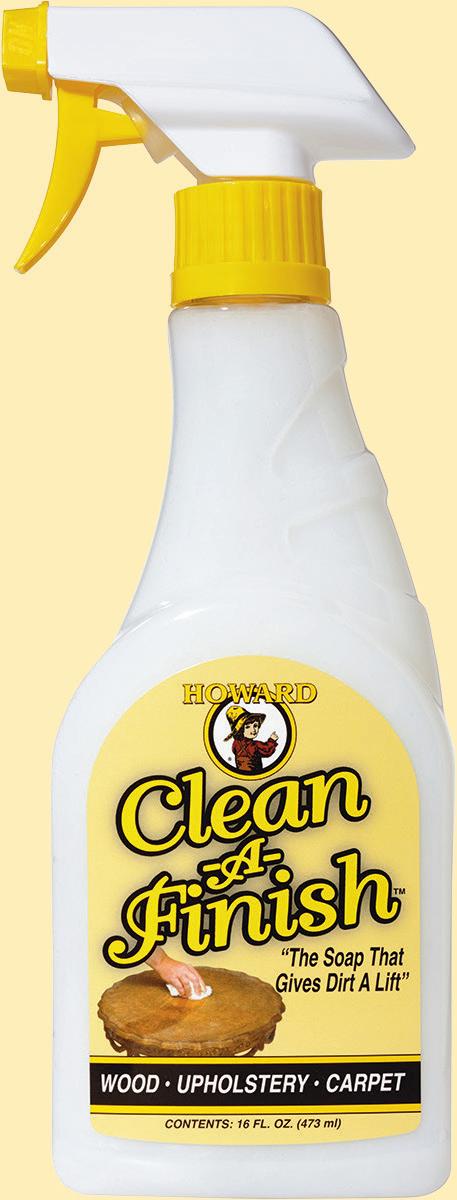

BUSINESS FOR SALE
Northwest Farm & Home Supply Co.
Location: Lemmon, SD
Gross Revenue: $3.21 million
The main building is a total 27,213 sq. ft. of retail and warehouse space on 4 acres. The main bldg. was constructed in 1994 with additions constructed in 2002 and 2004. Single story with 22’ clear height in 11,459 sq. ft. of lumber warehouse, three grade level doors and two dock height doors.
BUSINESS FOR SALE
Hoosick True Value
Location: Hoosick Falls, NY
Gross Revenue: $1.26 million
Price: $1.875 million
This opportunity offers a turnkey sale of a general hardware business located in northeastern Rensselaer Co., New York. The business serves five towns and southwestern Bennington Co., Vermont, and 25 miles east of Troy, New York.
BUSINESS FOR SALE
Home Improvement Supply Store
Location: Missouri
Gross Revenue: $1.04 million
This historic home improvement and hardware store is a staple of its community and operates from its headquarters in the Kansas City Metropolitan Area of Missouri. The Company is a long-standing retailer and installer of consumer and commercial improvement products.
BUSINESS FOR SALE
Albrights Hardware & Garden Center
Location: Allentown, PA
Gross Revenue: $1.9 million Price: $800,000
Albrights Hardware is an established hardware store with strong neighborhood ties and has been a Lehigh Valley staple for over 50 years. The current owners have owned the store since 1992. Albrights serves its loyal customer base by providing quality products and exceptional customer service.
BUSINESS FOR SALE
Central Vermont Paint, Flooring and Decorating Business
Location: Vermont
Gross Revenue: $2.82 million
Price: $1.1 million
Full-service decorating store providing flooring, paint, window treatments, kitchen/bathroom remodeling, cabinetry product offerings, design assistance, specialized service, and professional installation.
BUSINESS FOR SALE
Private Business
Location: Alabama
Gross Revenue: $2.21 million
Price: $649,000
BUSINESS FOR SALE
Private Business
Location: Pennsylvania
Gross Revenue: $1.6 million
SEEKING BUSINESSES
The Aubuchon Company
For our next acquisition, we are looking for:
• Single-store and multi-store hardware operations
• Located in northeast and southeast United States
• Store size of 5,000-30,000 ft 2
• At least $3 million in average store sales
SEEKING BUSINESSES
Bolster Hardware
We are looking for:
• Geography agnostic
• With or without real estate
• Store revenues of $1.5M+
• We prefer to honor the family name and heritage in the local community by not changing the name
• We prefer to keep all employees as part of the acquisition
SEEKING BUSINESSES
Gold Beach Lumber Yard
We are looking for:
• Single-store and multi-store hardware operations
• Located in the Pacific Northwest
• Store size of 5,000 ft2-30,000 ft2
Retailers share common obstacles to growth and how to overcome these challenges at PDRmag.com/growth-challenges
Gina Schaefer is the founder and former CEO of 13 hardware stores in Washington, D.C., Baltimore and their suburbs. She and her team of 300 have helped millions of customers shop right where they live, in their urban communities, despite continuous pressure from bigger, stronger competitors. Gina is a professional speaker and storyteller, engaging audiences on topics, including competing in a male-dominated field, building a strong corporate culture, business succession planning and all things small business. In her book, “Recovery Hardware,” Gina chronicles her experiences building a business while learning from nontraditional teachers like folks from the recovery community and returning citizens. She serves as an advocate and spokesperson for causes directly related to raising wages, anti-monopoly legislation and small business development.


CONNECT
Email gina@acehardwaredc.com
LinkedIn Gina Schaefer
Scan the QR code to learn more about Gina’s work to promote small businesses and second chances.

As tempting as it is to jump at every next shiny object (i.e. opportunity), I have come to realize over the years that a calculated approach to growth is a wiser idea. For the first 10 years of being in business, I drafted a strategic plan each year. No more than five pages, these documents provided my young team with a road map of sorts. We elaborated on marketing ideas, new competitors, our budget and expansion plans. We looked no more than two years out, keeping our options fresh and our planning flexible.
The expansion planning portion of this document was pivotal for us because once we started to grow, we didn’t look back. Growth can come from a variety of sources, and we wanted to dabble in all of them. To keep our enthusiasm in check, we devised a methodology for evaluating each component.
Over 18 years, we built 10 stores from the ground up, purchased five and closed two (closures are a topic for another day). There are very distinct reasons and steps to take when determining if you’ll start from scratch or buy an existing business, and every retailer I talk to has a different opinion on which one is better.
For today, however, I’ll share how we decide where to open a new outpost.
First, the community must have a strong “shop local” mentality. Is there a Main Street with already existing local businesses? Is there a business or community association that is tasked with being the local business megaphone?
We love these people and use their voice and muscle to boost our own marketing efforts long before our doors open for business.
While it never seemed quite as exhilarating, there is no doubt that aging or tired stores need new life breathed into them—and often. Over the years, we have tapped into Ace Hardware’s store improvement loan programs to overhaul several of our stores. The result has been as much as 25% sales increases and thousands of additional square feet of selling space, proving that customers also want new shiny objects. Everyone responds positively to these projects—the customers, the employees and the media.
Growing our product lines, which can be coupled with internal expansion plans, has also had a positive effect on our growth. We constantly evaluate what our neighbors need, not lump each of our thirteen communities together as one. One example of this is our pottery niche. What started as an effort to find more fashion-forward pottery for one location has turned into an almost $1.7 million niche across most of our chains.
The bottom line is this: growth for small businesses is important and can take on many forms. We rely on our team to be the eyes and ears of the store, pour over news from other industries and shop our competitors to ensure we are keeping up with trends, demands and new communities that might want a cool hardware store.
Gina Schaefer Founder and Former CEO A Few Cool Hardware Stores


•
•
•

















